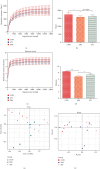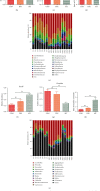Melatonin Alleviates Neuroinflammation and Metabolic Disorder in DSS-Induced Depression Rats
- PMID: 32802257
- PMCID: PMC7415091
- DOI: 10.1155/2020/1241894
Melatonin Alleviates Neuroinflammation and Metabolic Disorder in DSS-Induced Depression Rats
Abstract
There is a bidirectional relationship between inflammatory bowel disease (IBD) and depression/anxiety. Emerging evidences indicate that the liver may be involved in microbiota-gut-brain axis. This experiment focused on the role of melatonin in regulating the gut microbiota and explores its mechanism on dextran sulphate sodium- (DSS-) induced neuroinflammation and liver injury. Long-term DSS-treatment increased lipopolysaccharide (LPS), proinflammation cytokines IL-1β and TNF-α, and gut leak in rats, breaking blood-brain barrier and overactivated astrocytes and microglia. Ultimately, the rats showed depression-like behavior, including reduction of sucrose preference and central time in open field test and elevation of immobility time in a forced swimming test. Oral administration with melatonin alleviated neuroinflammation and depression-like behaviors. However, melatonin supplementation did not decrease the level of LPS but increase short-chain fatty acid (SCFA) production to protect DSS-induced neuroinflammation. Additionally, western blotting analysis suggested that signaling pathways farnesoid X receptor-fibroblast growth factor 15 (FXR-FGF 15) in gut and apoptosis signal-regulating kinase 1 (ASK1) in the liver overactivated in DSS-treated rats, indicating liver metabolic disorder. Supplementation with melatonin markedly inhibited the activation of these two signaling pathways and its downstream p38. As for the gut microbiota, we found that immune response- and SCFA production-related microbiota, like Lactobacillus and Clostridium significantly increased, while bile salt hydrolase activity-related microbiota, like Streptococcus and Enterococcus, significantly decreased after melatonin supplementation. These altered microbiota were consistent with the alleviation of neuroinflammation and metabolic disorder. Taken together, our findings suggest melatonin contributes to reshape gut microbiota and improves inflammatory processes in the hippocampus (HPC) and metabolic disorders in the liver of DSS rats.
Copyright © 2020 Wei-jie Lv et al.
Conflict of interest statement
The authors declare no conflict of interest.
Figures






Similar articles
-
Effect of Enterococcus faecalis 2001 on colitis and depressive-like behavior in dextran sulfate sodium-treated mice: involvement of the brain-gut axis.J Neuroinflammation. 2019 Oct 31;16(1):201. doi: 10.1186/s12974-019-1580-7. J Neuroinflammation. 2019. PMID: 31672153 Free PMC article.
-
Rattan Pepper Polysaccharide Regulates DSS-Induced Intestinal Inflammation and Depressive Behavior through Microbiota-Gut-Brain Axis.J Agric Food Chem. 2024 Jan 10;72(1):437-448. doi: 10.1021/acs.jafc.3c08462. Epub 2024 Jan 2. J Agric Food Chem. 2024. PMID: 38164789
-
Micro Integral Membrane Protein (MIMP), a Newly Discovered Anti-Inflammatory Protein of Lactobacillus Plantarum, Enhances the Gut Barrier and Modulates Microbiota and Inflammatory Cytokines.Cell Physiol Biochem. 2018;45(2):474-490. doi: 10.1159/000487027. Epub 2018 Jan 25. Cell Physiol Biochem. 2018. PMID: 29402771
-
Gut Microbiota and Neuroinflammation in Acute Liver Failure and Chronic Liver Disease.Metabolites. 2023 Jun 20;13(6):772. doi: 10.3390/metabo13060772. Metabolites. 2023. PMID: 37367929 Free PMC article. Review.
-
Melatonin as a Mediator of the Gut Microbiota-Host Interaction: Implications for Health and Disease.Antioxidants (Basel). 2023 Dec 23;13(1):34. doi: 10.3390/antiox13010034. Antioxidants (Basel). 2023. PMID: 38247459 Free PMC article. Review.
Cited by
-
Melatonin Attenuates Dextran Sodium Sulfate Induced Colitis in Obese Mice.Pharmaceuticals (Basel). 2021 Aug 21;14(8):822. doi: 10.3390/ph14080822. Pharmaceuticals (Basel). 2021. PMID: 34451919 Free PMC article.
-
Linking Nonalcoholic Fatty Liver Disease and Brain Disease: Focusing on Bile Acid Signaling.Int J Mol Sci. 2022 Oct 27;23(21):13045. doi: 10.3390/ijms232113045. Int J Mol Sci. 2022. PMID: 36361829 Free PMC article. Review.
-
Melatonin relieves hepatic lipid dysmetabolism caused by aging via modifying the secondary bile acid pattern of gut microbes.Cell Mol Life Sci. 2022 Sep 23;79(10):527. doi: 10.1007/s00018-022-04412-0. Cell Mol Life Sci. 2022. PMID: 36151409 Free PMC article.
-
Electroacupuncture Attenuated Anxiety and Depression-Like Behavior via Inhibition of Hippocampal Inflammatory Response and Metabolic Disorders in TNBS-Induced IBD Rats.Oxid Med Cell Longev. 2022 Jan 18;2022:8295580. doi: 10.1155/2022/8295580. eCollection 2022. Oxid Med Cell Longev. 2022. PMID: 35087621 Free PMC article.
-
Melatonin supplementation protects against traumatic colon injury by regulating SERPINA3N protein expression.Imeta. 2023 Oct 24;2(4):e141. doi: 10.1002/imt2.141. eCollection 2023 Nov. Imeta. 2023. PMID: 38868216 Free PMC article.
References
-
- Patten S. B., Beck C. A., Kassam A., Williams J. V., Barbui C., Metz L. M. Long-term medical conditions and major depression: strength of association for specific conditions in the general population. The Canadian Journal of Psychiatry. 2016;50(4):195–202. doi: 10.1177/070674370505000402. - DOI - PubMed
MeSH terms
Substances
LinkOut - more resources
Full Text Sources
Other Literature Sources
Medical
Research Materials
Miscellaneous

